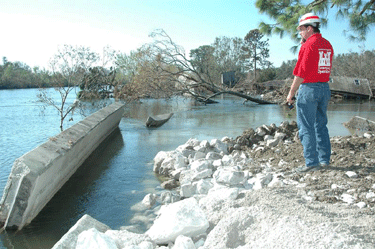The American Venice
Air Date: Week of September 23, 2005
Host Bruce Gellerman talks with former Secretary of the Interior Bruce Babbitt about his idea to turn New Orleans into an island.
Transcript
GELLERMAN: President Bush has promised to provide the funds to restore New Orleans. But what should the new New Orleans look like? A newer version of the old one? Or a city that boldly ventures into the forefront of the 21st century?
In the coming months there will no doubt be many proposals, controversial and competing. One of the first comes from Bruce Babbitt, the Secretary of the Interior in the Clinton administration. He offers a back to the future proposal of what New Orleans can be, combining the classical and the contemporary, with a look to the future.
BABBITT: Most of southern Louisiana is going to be underwater in the coming century as sea levels continue to rise another foot, two, maybe three feet. And so, as we begin to think about rebuilding New Orleans we gotta look around and say “how we’re going to do it?” And my conclusions was that we’re going to have to envision New Orleans as an island.
GELLERMAN: You actually mean to create an island out of the city? Would it be built up? Would there be a dike around it? A moat? How would that work?
BABBITT: Well, my vision of an American Venice, if you will, is you would begin with the existing levee system. You would simply recognize, though, that with the sinking of the Delta, which, of course, we’ve all come to understand is because we’ve mismanaged the Mississippi River. And the sediment that used to build the Delta and keep it above sea level is now being trapped in all those dams a thousand miles away up on the Missouri River. The rest of it, because of the levee system, is going out to deep water.
So, the Delta continues to sink, sea level continues to rise, and the levee system will simply have to be raised and strengthened. But not just up against Lake Pontchartrain and not just in bits and pieces, because the sinking Delta will bring the water all the way around. So it will take a large levee system, connected by a causeway that will go across open water for twenty, thirty, forty miles. Something like the Interstate across Lake Pontchartrain. But it will effectively be the principle and only access route into a city surrounded by water. GELLERMAN: Well, are those questions being asked now? Has your idea gotten any traction? BABBITT: Well I can’t say there’s been a, you know, stampede toward lining up at my door listening for advice. But the comparison that I’ve tried to lay out is what happened in Florida historically. In 1947 there were two huge hurricanes that put 90 percent of South Florida under water. Absolutely devastating. And out of that experience the Florida legislature invented some new institutions. They created an entity called South Florida Water Management District, gave it the powers to plan water management across the entire landscape of South Florida. And they’ve flood-proofed South Florida; there has never been a flood disaster since then. There’s been a lot of hurricanes and, mind you, plenty of damage localized from hurricanes. But the sort of Biblical floods that used to plague South Florida have been eliminated through broad, landscape-scale planning for the management of land and water. That’s what’s missing in South Louisiana right now. GELLERMAN: Any guesstimate on the cost associated with turning New Orleans essentially into an island? BABBITT: Well, it won’t be really any more costly than what they’re already talking about to rebuild it. And all I’m saying is we must, before we spend that money to replicate what was there two months ago, we better think about what the landscape and the waterscape is going to look like in 50 years. And then, rebuild the infrastructure of the island, including the internal circulation, the streets, water, sewer, infrastructure and the levy itself and the connection to the levees along the Mississippi River so that the city, if you will, is kind of, think of it as an American Venice. So there’s not vulnerable, ‘cause if it’s done in the same fashion as the past it’ll just be vulnerable from a different direction next time. GELLERMAN: You know, when you say American Venice, I really like that idea. I must tell you I can just hear the Zydeco music on gondolas. It’s a great idea. BABBITT: Well, I think jazz is a much richer tradition than those guys playing guitars on gondolas, actually. GELLERMAN: (Laughs). Secretary Babbitt, thank you very much. It was a real pleasure, sir. BABBITT: It’s been a pleasure. I enjoyed talking to you. GELLERMAN: Bruce Babbitt was the Secretary of the Interior in the Clinton administration. His new book is called “Cities in the Wilderness.” Living on Earth wants to hear from you!Living on Earth Newsletter [Click here]
Donate to Living on Earth! NewsletterLiving on Earth offers a weekly delivery of the show's rundown to your mailbox. Sign up for our newsletter today!
|






